SanDisk X300s (512GB) Review
by Kristian Vättö on August 21, 2014 2:15 PM ESTRandom Read/Write Speed
The four corners of SSD performance are as follows: random read, random write, sequential read and sequential write speed. Random accesses are generally small in size, while sequential accesses tend to be larger and thus we have the four Iometer tests we use in all of our reviews.
Our first test writes 4KB in a completely random pattern over an 8GB space of the drive to simulate the sort of random access that you'd see on an OS drive (even this is more stressful than a normal desktop user would see). We perform three concurrent IOs and run the test for 3 minutes. The results reported are in average MB/s over the entire time.

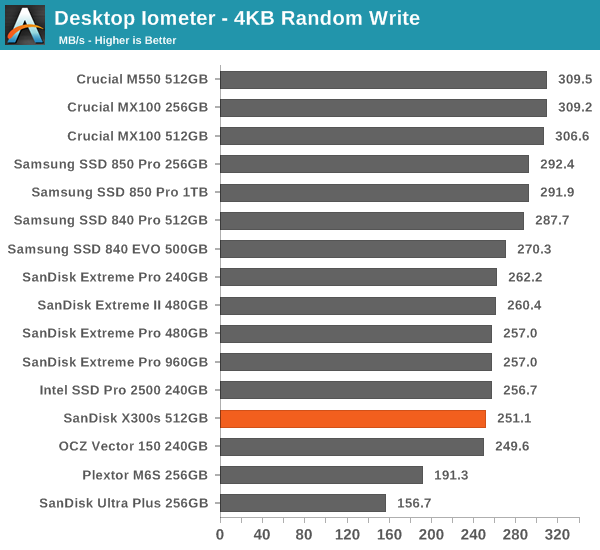
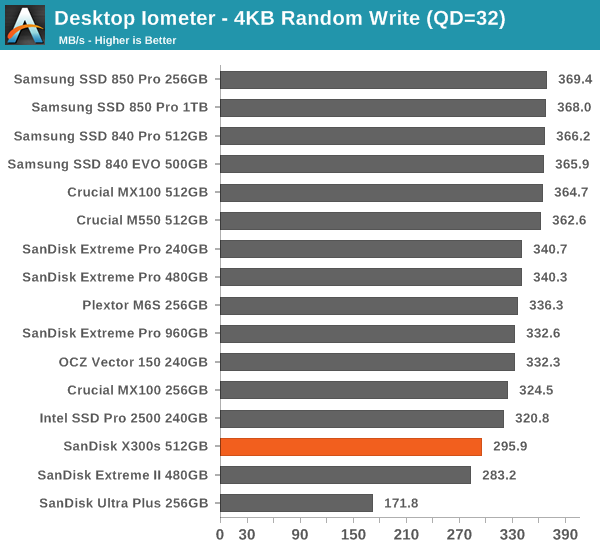
Random performance is similar to the Extreme Pro except for high queue depth write. Most client/corporate workloads do not go above queue depth of 5 anyway, so that should not be a problem.
Sequential Read/Write Speed
To measure sequential performance we run a 1 minute long 128KB sequential test over the entire span of the drive at a queue depth of 1. The results reported are in average MB/s over the entire test length.
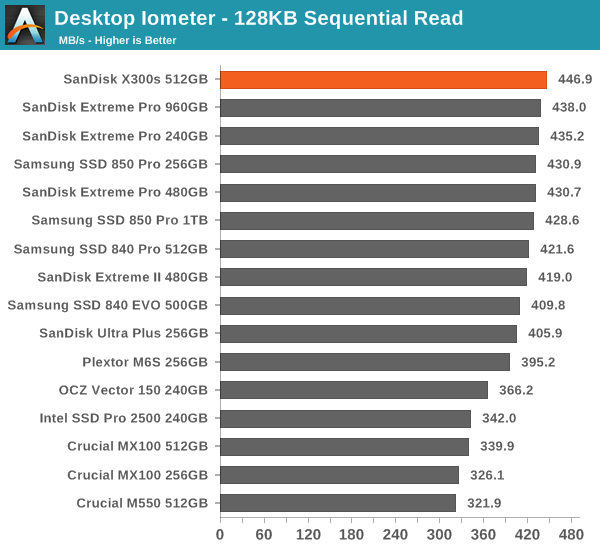
Sequential read performance is excellent and sequential write is okay too, making the X300s equivalent to the Extreme Pro.
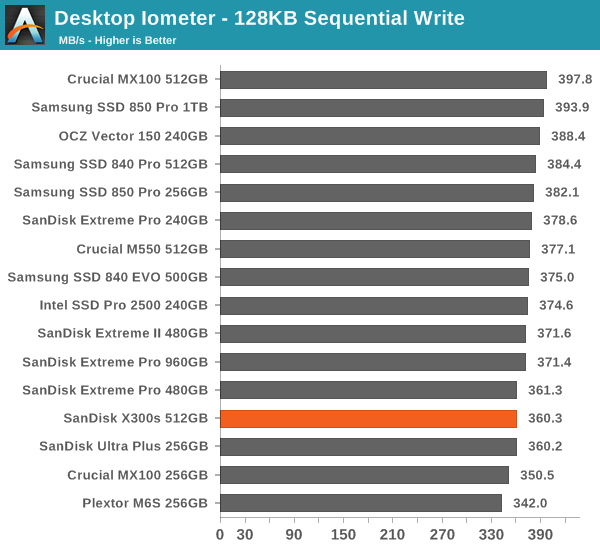
AS-SSD Incompressible Sequential Read/Write Performance
The AS-SSD sequential benchmark uses incompressible data for all of its transfers. The result is a pretty big reduction in sequential write speed on SandForce based controllers, but most other controllers are unaffected.
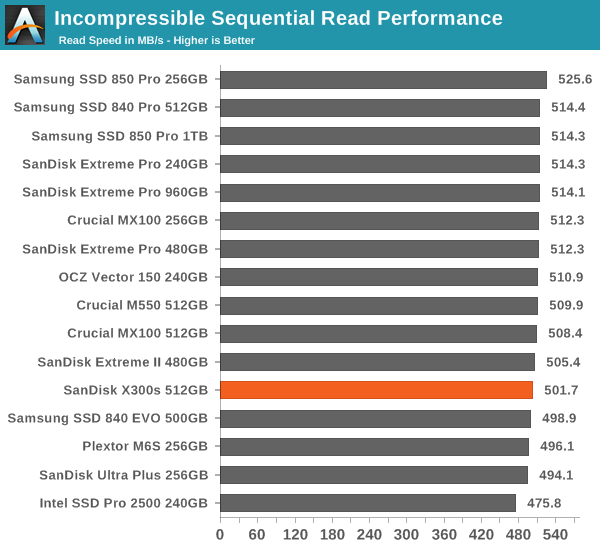
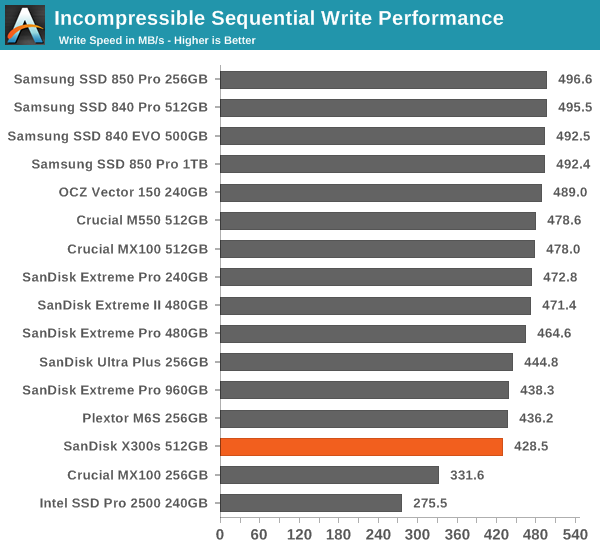










34 Comments
View All Comments
Kristian Vättö - Friday, August 22, 2014 - link
That is not true. Windows 7 is still the dominant OS in the enterprise space with Windows 8 only having a marginal share:http://www.sysaid.com/company/press/382-global-win...
Yes, that is one-year-old data but it shows that enterprises are not very keen on W8 and are adopting it very slowly. That in turn leaves a huge market for solutions like Wave ECS since the BitLocker in Windows 7 does not support Opal.
Besides, eDrive/BitLocker is the same for every drive. I don't see the need to revisit it with this drive because the process is not any different.
cbf - Friday, August 22, 2014 - link
Well, that market share article is from June 2013.While, I don't think Windows 8.1 is taking the market by storm, I think it is creeping in. I've deployed it due to things like improved startup/hibernation, BitLocker improvements, etc. The start menu just isn't that big a deal for my users.
In any event, it looks like we'll see Win 9 in the next six months, which I predict enterprises will deploy as fast as they've ever deployed any new Windows OS, so that should settle the issue.
jabber - Saturday, August 23, 2014 - link
Maybe not.Windows 9 is too soon. A lot of corps are only two years into their OS refresh, they aren't going to change till maybe 2017 at the earliest and then 10 is round the corner. A lot haven't moved to 7 till this year so they are going to hang around till 2020. Windows 10 will be the one that fits the schedule better.
9 will bomb probably. Plus anyone knows that 9 is purely a rushed damage limitation excercise.
devione - Thursday, August 21, 2014 - link
Hi Kristian,Really appreciate your efforts. However would it be possible to see future reviews involving Enterprise-grade SSDs? Thanks for your time.
Kristian Vättö - Friday, August 22, 2014 - link
Yeah, we have something in the works :)jay401 - Friday, August 22, 2014 - link
By the way, the Samsung 840 Evo in 256GB and 512GB sizes just dropped $20 and $50 in price on Amazon. $119 and $199 respectively, though the 500GB did just bump back up slightly to $212.7amood - Friday, August 22, 2014 - link
I appreciate the SEDs but I think these aren't open source and can't be audited like TC which is being audited right now. How to know for sure that the SED encryption is secure and doesn't have backdoor code for the spying?fk- - Saturday, August 23, 2014 - link
I'm still a bit confused about one thing - with all that security software listed in the table, what are the motherboard requirements to use the encryption on this drive? Do I still need a motherboard capable of setting ATA password if I want to password-protect the data on the drive?Or, to put it straight, is there any [software] way to use the option to password-protect the drive (and being prompted to enter the password on startup) on an older motherboard without UEFI, without ATA password capabilities and without Opal certification?
Kristian Vättö - Sunday, August 24, 2014 - link
Wave's ECS should do that as long as the drive is Opal certified. I tested without UEFI and it worked fine, and ATA password is just a BIOS feature whereas Opal is independent from the rest of the system (i.e. should work with any motherboard or system).mike8675309 - Sunday, August 24, 2014 - link
I assume that when you use the took to secure erase that when you enter the PSID that the drive is no deactivating the encryption, and then secure erasing the drive. Using that tool and that process must do something more complex so that avoids creating an attack vector.